![]()
NOTE: This page contains fairly large jpg and gif files so it
will load slowly.
Terminal ballistics is the science of what happens when the bullet strikes the target (and thus the mechanism of incapacitation). For a very long time this field was based on myths, misunderstandings, and in many cases outright misstatements. It wasn't until accurate and consistent tissue simulants and modern high speed x-ray photography started to be utilized that much of what happens began to be understood more fully. Even today there is still a lot of terminal "bull-istics" being put forth by self-styled experts based on so-called "street data," pet theories of the proponent, and some cases even manufacturer's incentives. However, those who have taken the time to research the subject and who understand the medical principles involved have learned to separate the bull from the bullets.
Note that while we are primarily talking about projectiles used in self defense the principals hold for hunting ammunition.
I have broken this page into two separate pages to speed up load time.
Fr. Frog's Rules of Terminal Ballistics
1) There ain't no magic bullets!
2) Only center hits count
3) Make the biggest diameter hole you can to let blood out and air in.
4) Small bullets may expand, but big bullets never shrink.
5) Make the deepest hole you can to ensure that vital organs and nerve centers can be reached and
destroyed from all impact angles.
6) "Service" your threat until it is no longer a threat.
7) No small arm can guarantee 100% instant incapacitation of a determined adversary--man or beast.
8) Don't believe manufacturer's claims.
9) Inconsequential increments are meaningless.
10) Most gun writers are pathological liars.
Armor Piercing - A bullet constructed of hardened material or carrying a hardened core specifically designed to penetrate bullet resistant, or armor-plated targets such as tanks, trucks, and other vehicles. Depending on the definition used for "armored" any small arms ammunition could be considered armor piercing. As an example, a target designed to resist pistol ammunition can be penetrated by rifle ammunition, or a target designed to resist rifle fire ammunition can be penetrated by a heavy caliber weapon or a light cannon.
Fragmentation - The disruption of the bullet into many pieces caused by the forces of impact on the bullet.
Full Jacketed - A bullet designed with the core of the bullet completely encased in a metal jacket to prevent expansion of the bullet upon impact. Fully jacketed bullets generally give the deepest penetration of any bullet design, all else being equal. The can be constructed with a lead core and a very thick copper or steel jacket, or they can be a solid metal bullet, usually made of copper, bronze, or gilding metal, known as a monolithic solid
Geneva Convention(s) - Some people claim that the use of "hollow point bullets" is illegal in warfare under the Geneva Convention (which is a set of international agreements to provide for "civilized" behavior between nations at war). The topic was actually addressed by the Hague Accords of 1899 and 1907 and proscribed the use of "arms, projectiles, or material of a nature to cause superfluous injury" (or in some documents "unnecessary suffering") and neither term is defined. By the way the conventions only apply to a declared war against national enemies by signatory parties. The US is not a signatory of this convention, but does abide by it. The hoplophobic press also latches on to this whenever those "evil" dum-dum, cop-killer, flesh shredding, crime causing bullets are mentioned by the gun grabbing liberals.
Hollow Point - A bullet (usually of jacketed construction) designed with the core of the bullet exposed by means of a cavity in its nose to facilitate expansion upon impact. Actual expansion can be altered by intervening material or by the bullet's construction.
In regards to the use of "open tip match" bullets which provide increased accuracy and which are not specifically designed to expand, the Hague Convention IV of 1907 (and NOT the Geneva Convention) does not proscribe bullets which yaw and fragment in tissue. This position was not disputed by the 1978 UNCCW Conference and was reconfirmed during its’ review in 1994 - 1996. Thus the US Judge Advocate General office's 1990 decision to authorized certain OTM projectiles, which yaw and then fragment just like many FMJ bullets, for unrestricted land warfare use is perfectly legal under international law and neither the nannie-state UN nor any other organization have any grounds to protest their use.
If one wanted to get technical about this issue there is really no basic for proscribing a bullet that does expand, since a) there is nothing about them that causes "unnecessary suffering; and b) an expanding bullet is simply an attempt to make a small diameter bullet create a wound channel that a larger diameter bullet would, and most "expanding bullets create a less messy wound then fragmenting bullets do. In actuality this so-called "ban" is very misleading for while expanding projectiles may supposedly be proscribed, the use of mines, explosives, fragmentation, and flame weapons which indiscriminately shred and maim their victims are not.
Permanent Cavity - The permanent "hole" left in the target by the bullet's passage. It is caused by the crushing and cutting effect of the bullet. Depending on the bullet's design it can be quite large in diameter or hardly noticeable. Pointed or round nose non-expanding, non-tumbling bullets make the smallest holes.
Penetration Depth - The final depth of the projectile's penetration at the end of the permanent cavity
Semi-wadcutter - A bullet designed with a sharp bore diameter shoulder the enhances its cutting action without requiring expansion.
Soft Point - A jacketed bullet designed with the soft core of the bullet exposed at its nose to facilitate expansion upon impact. Softpoint bullets tend to give slower expansion and deeper penetration than hollow points all else being equal. Actual expansion can be altered by intervening material or by the bullet's construction.
Stopping Power - A popular but imprecise term meaning Wound Trauma Incapacitation
Temporary Cavity - The boundary of the temporary displacement of tissue by the hydrostatic effect (fluid pressure) of the bullets passage.
Wound Trauma Incapacitation (WTI) - The inability of a human or animal to continue purposeful action due to the effects of being struck by a penetrating missile.
The subject of incapacitation is one of vital interest to anyone who depends upon a firearm to either protect their life from an assailant or who needs to stop a dangerous animal. What is needed in both cases (and even in the case of a non-dangerous game animal) is to turn off--S T O P--whatever the target is attempting to do, whether it is trying to kill you, someone else, or simply trying to run away. Whether or not the target eventually dies of the wound(s) is of only academic interest at the moment the shot is fired. You want (need) instant (or as near to instant as you can get) results! This function is commonly referred to as "stopping power" but a more precise term is Wound Trauma Incapacitation (WTI).
Interestingly, while the hunter, police officer, or civilian has always been interested in the immediate termination of all actions of the individual or animal that was shot, the military hierarchy is for the most part, has been primarily interested in creating a wound that will require medical treatment and hopefully the use of several other enemy troops to help the individual who was hit--which takes several people out of combat effectiveness with one wound. Thus, the military considers that an "effective" hit as one that simply delivers approximately 53 foot pounds (some sources say 35) of energy to the target rather than one that instantly shuts down the target. Thankfully this attitude is being replaced with the proper mindset. (The poor GI actually IN combat wants the same results as the hunter, police officer, or civilian--making the other guy stop trying to kill him. As the famous Patton quote goes, "... making the other dumb bastard die for HIS country.")
For a long time many individuals believed that the the mechanism of incapacitation was either energy transfer (how many foot-pounds of bullet energy was dumped into the target) or the size of the temporary cavity caused by the "shockwave" of the bullet's passage, or as some writers would have you to believe, the brand of ammo (usually the brand that they were getting free).
There are four components of projectile wounding. While not all of these components relate entirely to incapacitation they must all be considered.
Penetration. The depth of tissue through which the projectile travels and which it disrupts or destroys.
Permanent Cavity. This is the volume of space once occupied by tissue that has been destroyed by the passage of the projectile. In other words, the hole left by the bullet. It is a function of penetration and the frontal area of the projectile
Temporary Cavity. This is the temporary stretching of the permanent cavity due to the transfer of kinetic energy during the passage of the projectile.
Fragmentation. This is projectile pieces or secondary bone fragments which are dispersed outward from the permanent cavity. They may cause additional tissue damage. It does not normally occur at handgun velocities and if it does the fragments are usually within 1 cm of the permanent cavity. Note: At rifle velocities greater than about 2400 fs the fragments can travel several centimeters and greatly increase the permanent cavity and tissue damage.)
Modern medical science has shown us that the mechanism of incapacitation, while still not completely understood is based on two components. First is the rapid loss of blood and permanent tissue and nerve destruction caused by the the cutting and crushing action of the bullet's passage or the destruction of the central nervous system. The second component is not as easily as quantifiable and is the physical and emotional state of the target. A target pumped up on adrenaline or affected by narcotic or psychotic drugs can be extremely resistant to bullet caused trauma while a target full of fear and self doubt may "cease and desist" from a very minor wound. Since we cannot control the target's physical or mental state we have to just worry about doing all damage that we can TO the target.
Some will state that bullet placement is also a component. While in actuality it does play a part in the final results it is not a component of ammunition/bullet performance. A well placed hit that causes inadequate damage may be of infinitely less use than one that causes massive and deep damage in a less well placed hit. (Although, ideally what you want is a well placed hit that cause massive damage.)
Let's look at some of the theories, past and present.
Energy Transfer School - In this school of thought the more foot pounds of kinetic energy a bullet "dumps" (loses) in its journey through the target the more effective it should be in incapacitating the target. The measurements were derived by measuring the bullet's velocity at impact and also its exit velocity (if any) and then comparing the kinetic energy of the projectile at those two velocities. The difference was considered the energy transferred to the target. Under this theory a .22 Long Rifle bullet which did not exit the target could be more "effective" than let's say a .357 that blew right through the target. (While this is an extreme example you get the point.) What the bullet did TO the target while traversing it was not examined. This school of thought favored light-weight high-velocity bullets which possessed high kinetic energy and which usually did not exit their target. To give you an idea about problems with this idea "authorities" have stated that delivering between 35 and 270 ft/lbs of energy is "effective." That's almost a 9x discrepancy and there has never been any scientific or medical proof that KE does anything to soft targets. One of the most famous of the energy dump studies was done by DeMaio, in the late 60s.
Temporary Cavity School - In this school of thought the larger the temporary cavity made by the bullets passage the more effective it should be. The measurement of the temporary cavity was derived by measuring high speed x-ray photographs of the temporary cavity displaced by the bullet on the theory (never proven) that the farther tissue was displaced the greater the nerve trauma. The actual damage done by the bullet was ignored. In general the faster the bullet is traveling the greater the temporary cavity, all else being equal.
Several thing have proved wrong with this theory. First of all, as any surgeon knows, muscle and bowel tissue is very elastic. During surgery such tissue can be moved substantial distances without any harm to the person. Second, most temporary cavities are quite shallow (although bullet design plays a role here) and thus do not effect much in the way of vital organs. Third, the temporary cavity is not very large with pistol rounds (not much greater than about 4" in diameter) and of very short duration. Unless the limits of elasticity are reached (which take velocities in the 2200 f/s and higher range) no permanent damage or injury results. The exception to this is inelastic tissue such as organs like the brain, liver, kidneys, and spleen--but counting on hitting one of those organs is a risky business. This school also tends to favor high velocity although bullet construction/performance is also considered.
The most famous of these studies was the "Relative Incapacitation Index" study done by the the National Institute of Law Enforcement and Criminal Justice in the early 70s using their "computer man," and which was almost immediately invalidated due to false assumptions, blatant data errors, and the use of 20% gelatin instead of 10%.
It should be noted that there is, however, an instance where the temporary cavity may aid in the WTI process. That instance is when the a high velocity (> 2400 fs) rifle bullet fragments during the creation of the temporary cavity. Temporary cavities from most high power rifles can be 5 - 8 inches in size, and this can sometimes cause the tissue to suffer somewhat more damage than by just the bullets passage alone as the tissue can be cut or damaged during its stretched or stressed state by the bullet fragments and thus create a somewhat larger permanent cavity. If the wound is deep enough this can increase the incapacitation effect. This effect is seen with the military ball ammo fired in the full sized M16 rifles.
The "Hydrostatic Shock" School - This school of though, which is sort of an adjunct to the temporary cavity school, thinks that the "hydrostatic shock" or hydraulic pressure wave of the bullet's passage travels through out the body and shocks the brain and nervous system into momentarily shutting down which disables the target. Tests have been run with instrumented pig carcasses and other than in the immediate vicinity of the bullets passage no significant hydraulic effect was noted.
Big Hole School - In this school of thought, sometimes referred to as the Fackler/IWBA school, and the medically correct one, the more permanent damage that is done to the target (and incidentally the more rapidly the target bleeds out) the more effective the bullet and more likely incapacitation. The more tissue cut, crushed, and/or destroyed by the bullet's passage the better, as more real system trauma results. In addition, in order to be effective at all target angles the bullet must penetrate sufficiently to reach vital organs in the target no matter from what direction the bullet impacts. Most authorities agree that for anti-personnel use a minimum penetration in calibrated ballistic gelatin of about 12" (with 14" - 15" being considered ideal) is needed. This is necessary to achieve reliable performance under all conditions against a human target. It should be noted that minimum depth for major blood vessels and organs in a human is about 15cm ( 6")--from straight on, but it is considerably more from various angles. With bullets used for hunting the general consensus is the deeper the better. In both cases this has to be coupled with the ability to create the largest diameter permanent hole possible. Most authority seem to agree that the permanent hole needs to be at least .4" or greater in diameter and as deep as possible. A problem arises here in that as a bullet expands it tends to penetrate less, so expansion and penetration have to be carefully balanced by bullet weight and bullet construction. This bullet design problem is exacerbated by the fact that if a target is covered by some material such as cloth, glass, metal, etc. the expansion--and hence the penetration of the bullet--can alter dramatically.
The big hole school tends to favor medium to heavy weight bullets at moderate velocity, with a general preference to bullets of .40 caliber and greater, that penetrate deeply and destroy a lot of tissue in the process. The stated requirements for optimum performance are:
A Quick Note on Bullet Diameter - Some folks who think the 9 mm is the perfect round say "how can a "silly millimeter" between a 9 mm / .355" and a 10 mm / .40" make any real difference. What they are missing is the fact that it's not the diameter that's important, but rather the area of impact that determines the amount of damage produced--the reason we like to use expanding bullets. Note the how the percentage of impact/damage area increase as bullet diameter goes up. Since expanding bullets frequently do not expand it makes sense to start with a bullet diameter you'd like the 9 mm bullets to expand to.
| Bullet diameter (in) | Impact Area (in2) |
Area increase |
| 9 mm (355") | .098 | -- |
| .38/.357 (.357) | .101 | 2% |
| 10 mm/.40 (.400") | .125 | 27% |
| .41 (.410") | .132 | 34% |
| .44 (.430") | .145 | 47% |
| .45 (.452") | .160 | 63% |
Incidentally, round or pointed nose, non-expanding bullets tend to push tissue aside rather than crush it, and the permanent cavity for a non-tumbling bullet of these designs usually runs about 65 -70 percent of the diameter of the projectile. Non-expanding heavy jacketed or monolithic (solid metal) projectiles with large metplates yield permanent cavities of between 70 and 80 percent of the diameter of the projectile (and the large metplats helps them to penetrate in a straight path rather than veer off. ) The very blunt and often sharp-edged shape of an expanded projectile can yield a a permanent cavity of between 80 - 90+ percent of the expanded projectile's diameter.
The most famous of these studies is the FBI "Ammunition Standards" testing and evaluation done in the late 80s which attempted to rank ammunition effectiveness. While the study was well done and showed the effectiveness of making a large diameter and deep hole the ranking system was flawed because of the following test assumptions
The FBI has since stopped ranking the ammunition and has just started to publish the test results themselves. I personally think that a ranking system based solely upon a combination of actual penetration depth modified by the average dimensions of a human torso (to discount cavity volume outside the depth of a torso), and the volume of the permanent cavity might make a useful ranking system if the statistical caveats could be worked out.
One word about depth of penetration. Some people in law enforcement hold that too much penetration with ammunition used for self defense is a bad thing. They fearfully warn that a bullet that passes through a target may hit someone else resulting in all kinds of law suits. However, considering that according to action reports from the NYPD that 80 - 90 percent of the shots fired in law enforcement situations fail to even hit the target (Gunsite, Thunder Ranch, and a few other school grads excepted!) I wouldn't worry too much if your ammo is penetrative. Better too much than not enough when the chips are down. However, ammunition that meets stated requirements above for optimum performance will in most circumstances not exit with a frontal torso hit
Interestingly, the big hole school has always been accepted in the dangerous game hunting field as the way to go, yet for some reason tissue damage and deep penetration have taken a while to be accepted by handgunners. Maybe the reason that energy dump and temporary cavity believers aren't vocal in the hunting area is that it is hard to pontificate when you are in between the toes of a cape buffalo or in a lion's or bear's stomach. Another interesting observation is that much of the existing medical literature on bullet wounds is still full of misconceptions and false statements. While things seem to be slowly improving there is quite a way to go for medical literature to catch up with the truth. (The whole "I have a theory" that is then taken as gospel movement is the same one that seems to infect the global warming folk.)
The Bullet of the Month School (The Magic Bullet School) - This school of though is pushed by the unscrupulous manufacturers of some bullets that they claim are magic, and the gun writers who receive free samples and other perks laud them without scientifically testing them. These include things like bullets made of esoteric substances (like the "blended metal" bullets) and bullets with unusual shapes, construction ("exploding" bullets), or other properties. Most are things that have been dreamed up long ago and have been resurrected in an attempt to make money and are consistently shown to be no better than or usually worse performers than more conventional designs when tested.
A couple of things to note in regards to damaging the "target." First the vital organs in a human torso are placed much higher in the chest than many people believe, and your aim point should be between the armpits rather than "center of mass" when shooting a human adversary. Second, the central nervous system is actually not very large and is difficult to hit.
 |
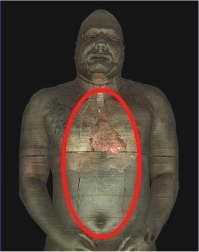 |
 |
| Organ layout | Vital organs are above the "center of mass." | The central nervous system. |
The graphic below shows a cross section of a human torso. Note that for a bullet to be able to reach the vital organs from any direction but directly from the front that a bullet will have to penetrate quite a bit. The average torso is between 10 and 12" thick front to back, and while a 6" penetration may get the vital organs from dead front, any shots from the side will have to penetrate significantly more, which means that a bullet should have a penetration of 12" or more to be affective from any angle.
 |
|
Cross section of actual human torso |
Anatomical cross section and
transparent man images courtesy University of Colorado, Center for Human
Simulation
http://www.uchsc.edu/sm/chs/open.html
Anatomy of a Bullet Wound
One of the tools used to compare the effects of ammunition is the "wound profile." Wound profiles are simply dimensioned photographs or carefully prepared scale drawings of test firings in calibrated ballistic gelatin. The wound profiles below are some typical examples of what a bullet does on impact.
Surprisingly more work with wound profiles has been done with handgun ammunition than with rifle ammunition used for hunting. This is a fertile field for researchers.
Properly prepared and calibrated ballistic gelatin gives performance and penetration results within about 2 percent of of results obtained in actual tissue. "Properly prepared" means that the gelatin is a 10 percent mixture of ballistic gelatin (Kind and Knox Type 250) prepared with water heated to no more than104° F (40° C) and then stored and shot at a stabilized 39° F (4° C). Click here for the procedure for making ballistic gelatin.
Please note that gelatin testing cannot be used to predict the "effectiveness" of ammunition. There are simply too many variables in real life.
Testing bullets in gelatin as a soft tissue simulant provides useful information about a bullet's terminal mechanical performance and wounding producing effect and nothing more. These two characteristics are directly linked to the bullet’s design, construction, and velocity.
Terminal mechanical performance is a measure of bullet penetration, expansion, fragmentation and yaw at a given velocity.
Wounding producing effect is the disruption produced by a bullet’s terminal performance characteristics in the target.
To be "effective" a bullet must inflict an injury that produces dysfunction of the central nervous system. This is accomplished by either or both direct physical damage to a central nervous system structure (the bullet must penetrate the brain or cervical spinal cord), or blood loss in quantity to rapidly deprive the brain of the oxygenated blood it needs to remain conscious (the bullet must penetrate a major cardiovascular structure). The effectiveness of ammunition is thus a consequence of shot-placement (the bullet’s path through the body), its penetration, and the tissue/organs destroyed. It cannot be measured in a tissue simulant. However, a bullet/ammunition that displays good wound producing effect in a calibrated simulant will most likely perform well in a live encounter, all things being equal.
"Keep in mind that ordnance gelatin is an approximation for living muscle, and most shots go through several tissue types. It is a rough approximation. The "correction procedure" can mislead in giving the impression that gelatin is a more exact technique than it really is. The important thing is to record the speed and penetration of the BB along with your data. I have worked, and continue to work, with many gelatin users; and don't know anybody who actually uses the correction procedure -- but they all record the velocity and penetration." -- Dr. Martin Fackler
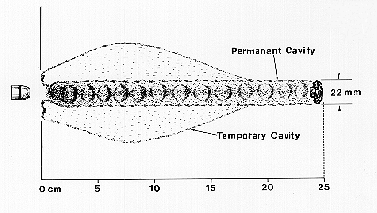
This particular profile is that of an early .45ACP 185gr. Silvertip Winchester @ 940 f/s. This is a classic non-fragmenting expanding bullet wound profile. The narrow portion at the start of the permanent cavity is called the "neck" and its length is a function of the bullet's design. This particular load is a little short on penetration at 25cm (9.8") with an expansion of .85". As a comparison the Hornady +P 230gr XTP at 880 f/s gave 15.6" penetration and .72" expansion, the Hornady 200gr XTP at 850 f/s gave 18.5" and .54", the Winchester 230gr Black Talon at 858 f/s gave 13.5" and .73", and the Remington 185gr at 1020 f/s gave 10.5" and .83". Interestingly, Winchester must have got the word on their 185 gr because a later lot of this ammunition gave 882 f/s and 11" of penetration and .74" expansion.
 |
For comparison the GI M1911 Ball ammo (230gr FMJRN at 869 f/s) produced a penetration of 26" with no expansion.
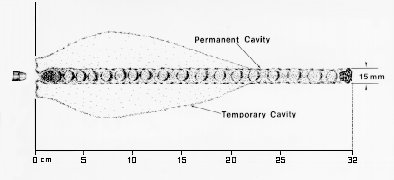
This particular profile is that of a ..38SPL +P 158gr. lead semi-wadcutter hollow point "FBI" load @ 880 f/s. This is another example of a typical non-fragmenting expanding bullet wound profile produced by an expanding bullet. This particular load shows good penetration at 32cm (12.6") and good expansion at .59". Perhaps this is one reason that this loading has a good reputation on the street. The Winchester Black Talon 9mm 147gr JHP at 981 f/s produced an almost identical profile with penetration of 35cm (13.8") and and expansion of .61". In the .40 caliber ammo the profiles were very similar with the Hornaday 155gr XTP at 1090 giving 14.3" penetration and .57" expansion, the 180gr XTP at 970 f/s giving 14.5" and .67", and the Winchester 180gr Black Talon giving 13.4" and .68".
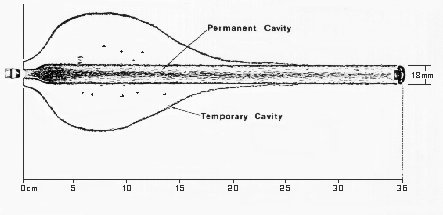
This profile is the Remington 125gr JSP .357 Magnum at 1390 f/s which has a generally good reputation on the street. Note the shape and size of the temporary and permanent cavities are very similar to the .38 Special round above and penetration is only about 1.5" greater. Expansion is .66", only .07" greater than the .38 round in spite of the vastly increased velocity. An excellent example of good bullet construction at work. The equivalent JHP round gives about 10 percent less penetration and a .70 expansion.
 |
This is the 9 x 19 mm NATO M882 124 gr FMJ round and is typical of small diameter round nose FMJ projectiles. Note that the permanent cavity is very small and the projectile doesn't start to tumble until about 20 cm of penetration. Not impressive nor effective in spite of the 1200 f/s velocity.
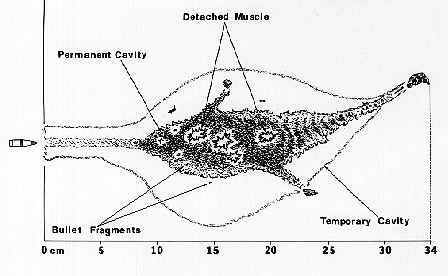
This profile is the M855 5.56mm NATO cartridge, with a 62gr steel core FMJ boat tailed bullet @ 3035 f/s. This is a classic fragmenting rifle bullet profile. Penetration is acceptable at 34cm (13.4"). Note the long narrow neck of about 9 cm (4") before the bullet tumbles and fragments. (The length of the neck can vary from 9 cm to about 20 cm depending on impact velocity (one of the reasons for its erratic performance). The original M193 55gr round produces a similar profile but it has a longer neck, and slightly smaller temporary and permanent cavities. Both of these bullets fracture violently at the cannelure at velocities above about 2700 f/s. Below that velocity the bullets may break into several large pieces or simply tumble without producing the extensive permanent cavity, much like the 7.62 mm M80 ball round.
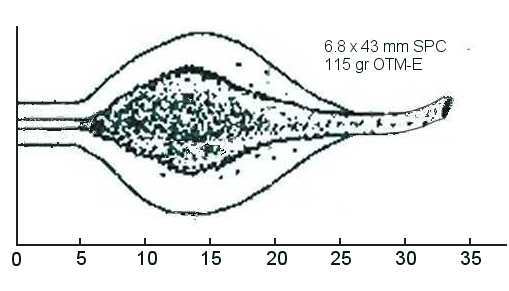
This is the profile from the 6.8 SPC (6.8 x 43 mm) with the 115 gr Sierra Enhanced Fragmentation OTM bullet at 2620 f/s. Note the short 6 cm neck, good fragmentation, and permanent cavity. If the bullet expands rather than fragments the profile is very close to this with a slightly shorter neck and a tail that goes straight with a penetration of between 35 and 38 CM.
| Continue to the second page of terminal ballistics |
Credits
Wound profiles courtesy Dr. Martin Fackler
Gelatin photograph courtesy of Letterman Army Institute of Research
Anatomical images courtesy
University of Colorado, Center for Human Simulation - http://www.uchsc.edu/sm/chs/open.html
Please email comments to Fr. Frog by clicking here
| Ballistics Main Page | External Ballistics Page | Zeroing Page | Internal Ballistics Page |
| Rifle Power Page | Misc. Questions |
| Back to Fr. Frog's Home Page |
Disclaimer
As far as I know all the information presented above is correct and I have attempted to ensure that it is. However, I am not responsible for any errors, omissions, or damages resulting from the use or misuse of this information, nor for you doing something stupid with it. (Don't you hate these disclaimers? So do I, but there are people out there who refuse to be responsible for their own actions and who will sue anybody to make a buck.)
Updated 2014-03-02